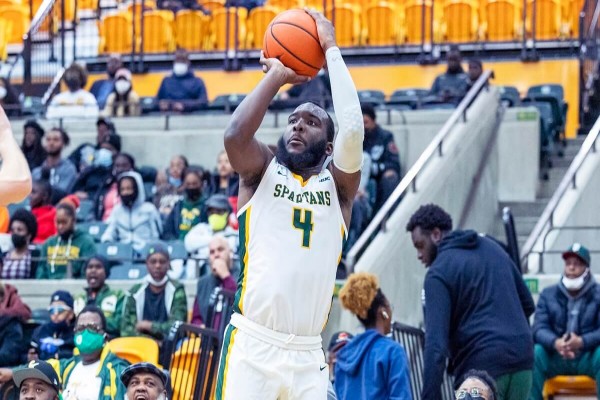Mid-Major Notebook (Jan. 5, 2022)
Coast To Coast : Mid-Major Notebook (Jan. 5, 2022)

Well, here we are again.
Cancellations and postponements are a nightly occurrence in college basketball. More than 100 teams have endured a pause to their season. When teams take the court, key players are absent, producing unusual lineups and unexpected results.
The ordeal is familiar and frustrating for the players, the coaches, the fans. Momentum gained during the preseason and nonconference schedule feels lost to days, if not weeks, of inactivity. Coaches love practice. They organize, control and administer those sessions. It’s part of the routine. The place where they teach and improve, mold a team. When the routine is disturbed they can be as cranky as a toddler.
The good news is college basketball, the conferences and schools were better equipped to handle the fallout as the Omicron variant entered the lexicon. The coaches I’ve spoken with expected disruption coming out of the holiday break. Most feel the schedule will remain in disarray for another week or two. The high vaccination and booster rates among players and staff give them hope this wave will be brief. Conferences are announcing rescheduled games at a brisk clip.
The interruptions are inconvenient and sometimes inexplicable. It seems unfair and unnecessary to cancel a game less than an hour before tipoff, which occurred more than once in the past week. The empty arenas, void of fans and bands, paint a sad scene and hopefully the exception rather than the rule.
But the big picture is brighter than it was a year ago - although it probably doesn’t feel that way in the CAA, which played the fewest games of any conference last season and had its 5-game Wednesday slate wiped out by the virus.
In a month, maybe we’ll talk only of buzzer beaters and bracket busters while enjoying what figures to be the busiest February ever as teams jam makeup games into the year’s shortest month.
The chance of a full regular season is within reach. The NCAA still plans to host the tournament at various sites around the country, per usual.
It’s not dark yet and, fingers crossed, we’re not going there.
BUCKET GETTERS
By this time each season, coaching staff have hours of video to study. They can call out an opponent’s plays from the sidelines and have analyzed the strength and weakness of each opponent. All the stuff drawn on the locker room whiteboard is great. But in the ultracompetitive land of conference basketball, in a year where extra eligibility and the transfer portal gave most teams a viable roster, one fact remains. You need a bucket getter. A bucket getter is usually a guard. He’s more comfortable driving the lane than shooting a 3-pointer - but granting him too much space beyond-the-arc is a losing deal. The free throw line is a familiar place for a bucket getter. Every coach needs one. Some have two. The guy who can handle the ball late in the shot clock, late in a close road game and induce silence with one smart play.
Here are my four favorite mid-major bucket getters. Look for them soon in an arena near you.
Darius McGhee, Liberty - The 5-9 guard is smaller than the prototype but no less effective. He’s converted 57 percent of 2-pointers vs. D1 teams this season while also making more than three 3-pointers per game. Undeterred by a cold shooting stretch, McGhee has launched 37 percent of the Flames’ field goal attempts this season, the nation’s second highest rate. Ritchie McKay rests easy with McGhee at the helm and the three-year starter has helped Liberty, the Atlantic Sun favorite, to a 10-6 record, including a 16-point win at Stetson in the conference opener.
Tevin Brown, Murray State - After a quiet opening 19 plus minutes against Chattanooga last month, the 6-5, 175-pound junior buried a 35-footer at the halftime buzzer to pull the Racers within three points. The buzzer beating bomb ignited the crowds and Brown, who dominated the game in the second half en route to a career-high 33 points. The latest in a line of star guards in Murray, his shooting, playmaking and verve are why Murray is 11-2 and why its two games with OVC rival Belmont will be something to see.
Malachi Smith, Chattanooga - The leading candidate for Southern Conference player of the year, Smith is starring in his second season with the Mocs. He’s made 58 percent of 2s, 39 percent of 3s and 86 percent of free throws thus far and draws 4.8 fouls per game. His sturdy 6-4, 205-pound body and slick ballhandling skills enable Smith to probe the perimeter or penetrate the lane. The Mocs love to grind out victories at a deliberate pace. Having a closer like Smith makes them the worthy SoCon favorite.
Joe Bryant Jr., Norfolk State - The Spartans’ backcourt leader doesn’t mind lurking in the background for the first 30-35 minutes of games, making sure he’s distributing the ball and his teammates are finding their rhythm in the flow of the game. But when winning time comes around he steps to the forefront, hitting timely 3-pointers and charging to the rim. The fouls come frequently and Bryant Jr. (pictured above) makes each trip count. He’s hit 47 of 49 free throws vs. D1 teams for 9-4 Norfolk State, which figures to battle Howard and others for the MEAC crown.



